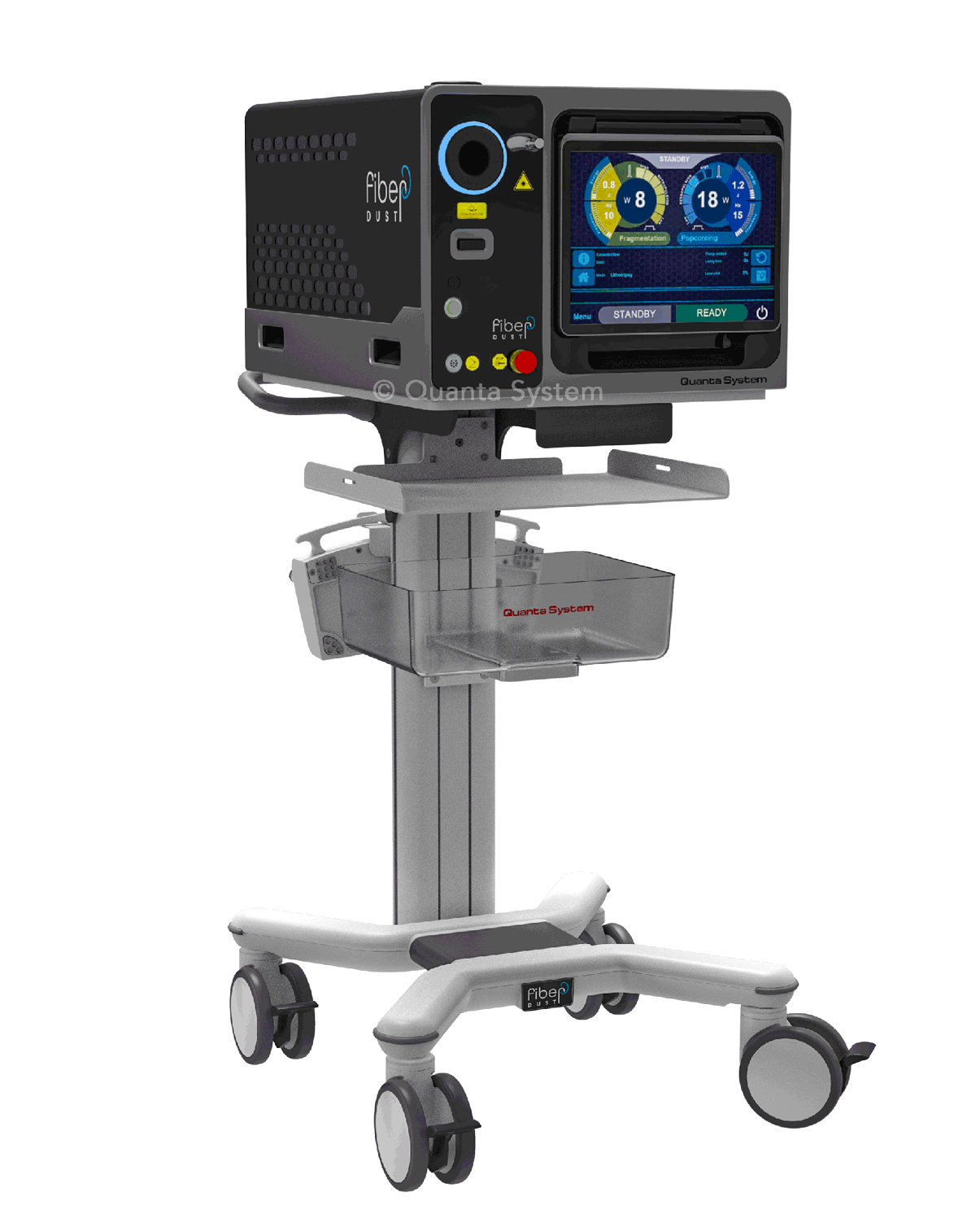
Quanta System Fiber Dust®: Thulium Fiber Laser
Key challenges for US hospitals
Today’s operating room is a marvel of technology. Recent innovations in laser technology that enable precise control of pulse duration, frequency, and intensity are unlocking new possibilities for surgery. No longer are devices such as lasers clunky and awkward—they are modern, elegant, and capable tools that provide a smooth, efficient user experience, and plenty of compelling benefits for surgeons, hospitals, and patients.
Lasers are also an integral piece of the technology puzzle for forward-thinking hospitals that aim to be patient-centric. Achieving patient care goals requires a total commitment to excellence as well as acquiring the technology tools to get the job done and help a medical institution build its reputation.
Demographics
With an estimated 70 million Baby Boomers in the United States, the healthcare system is feeling the crunch. As this generation ages, the need for healthcare services including surgical procedures will increase significantly. This explosion of demand will require hospitals and surgical teams to address various challenges that may contribute to long wait times for elective surgeries.
Innovative medical devices such as the Fiber Dust thulium fiber laser by Quanta System can help address the many obstacles that hospitals, surgical teams, and patients face during complex medical procedures.
Wait times
With surgical wait lists that are growing by the day due to shifting demographics, the need for technology to speed up surgery without compromising patient care objectives has never been greater. Surgeons and their teams are already working extremely hard, so forcing them to work harder is not the answer. Instead, they must work smarter to increase speed without impacting patient outcomes or surgeon ergonomics.
Efficiency
In procedures such as kidney stone removal, locating and ablating stones may be slower and more challenging if surgeons are forced to use obsolete technologies and methods. Ablation requires precision to avoid retropulsion, and dusting must break up calculi into sufficiently small pieces for elimination by the patient. Urological procedures are just one example of surgery types that may be inefficient unless leading edge technology is used—but there are many more.
Given the importance of identifying ways to increase efficiency, hospitals and surgeons alike will be searching for best practices that boost speed without impacting patient and surgeon safety.
Surgical center staffing levels
A major part of providing high quality surgery is attracting surgical talent. Engaging, retaining, and postponing early retirements for top surgeons is a huge challenge for medical institutions. One way to address this obstacle is to provide tools that surgeons enjoy using in their work. Thus, providing the latest technologies that enable surgeons to increase productivity and enjoy their job is an important goal for American hospitals.
Safety
Delivering strong patient outcomes requires a combination of accuracy, sterility, and the reduction or elimination of complications. Obsolete tools and methods may impact patient safety in terms of clinical outcomes if additional complications are introduced. This is why innovative technologies such as thulium fiber lasers are so important in today’s surgical landscape, as they address very specific needs for surgeons, hospitals and patients.
Surgeon ergonomics
A recent study notes that the physical pain many surgeons experience as a result of the demands of their job may be increasing absenteeism and early retirements. Using premium tools featuring modern ergonomics is one way that hospitals can tackle the challenge of surgeon discomfort on the job.
Some surgeons have less muscle mass than others, and as a result, they have developed modified surgical techniques. An example is the need to use two hands to operate a surgical stapler at the end of a grueling procedure, rather than one hand (which is standard).
With so much variance in the ergonomic needs of surgeons, hospitals must provide tools that match patient needs as well as surgeon choices. Laser technology, with its small footprint, powerful output, and versatile modes of operation, can help to alleviate several of these pain points for hospitals, surgeons, and their teams.
Today’s operating rooms demand innovative technology
With demographic shifts and an aging population causing an increase in elective surgeries, hospitals are being pushed to the brink of their capacity and beyond. The need has never been greater for medical devices that can increase efficiency without causing undue harm to patients.
One such solution is thulium fiber lasers—and the Fiber Dust platform by Quanta System is a world leader in its category.
Introducing the Fiber Dust thulium fiber laser by Quanta System
The Fiber Dust system is a thulium fiber laser that excels in both lithotripsy and precise soft tissue surgery. Thulium fiber lasers have emerged as an alternative to holmium lasers, particularly for kidney stones.
Indications for use
Urological surgery
Recent decades have seen a significant increase in the number of minimally invasive surgeries being performed. Technologies such as thulium fiber lasers are commonly used in the field of urology, specifically for urolithiasis, benign prostatic enlargement (BPE), and urinary tract malignancies.
In terms of performance, one study notes that thulium fiber lasers can provide superior water absorption and lower thresholds for stone ablation. Specifically, given the relationship between water absorption and cell absorption, thulium fiber lasers enable more energy to be transmitted by cells, leading to better ablation.
Lithotripsy procedures
Breaking up stones requires precise technique. Speed and accuracy are paramount, and there is little tolerance for mistakes. With its power and flexibility, the Fiber Dust laser system is an excellent solution for lithotripsy.
Gastroenterological Surgery
For gastroenterologists, the Quanta Fiber Dust laser can be used for soft tissue excision, incision, resectioning, and ablation.
Soft tissue surgery and BPH
In soft tissue procedures, precision is critical. With the Fiber Dust platform, thulium wavelengths are strongly absorbed by water and this increases accuracy for incision and efficiency for ablation. Versatile thulium fiber laser systems such as the Quanta Fiber Dust can also be used in situations requiring a low to medium power machine such as for the treatment of bladder and UUT tumors, and stenosis.
Fiber Dust gives you the flexibility to choose between ThuLEP (super-pulse) and a more standard traditional continuous emission ThuLEP.
A versatile surgical laser system
The Fiber Dust thulium fiber laser is a flexible surgical platform giving surgeons the utmost in power and control. Here are a few highlights of the system.

Pulse adjustment steps
With Fiber Dust, surgeons can choose between continuous or pulsed emission. This gives surgeons full control over operating technique, enabling them to custom tailor laser work to each patient’s unique needs.
Adjusting the duration, energy, and frequency of laser pulses can achieve different patient outcomes depending on the goal of the procedure. Continuous emission occurs at a slightly lower power rate which provides a smoother and more gentle action. In contrast, pulsed emission has a higher peak power which improves stone lithotripsy and facilitates more aggressive tissue cutting with reduced charring.
Continuous or pulsed emission modes
The Fiber Dust system provides seven levels of adjustment with its MasterPULSE technology, where traditional systems only provide three. MasterPULSE enables fine-tuning of pulse duration and peak power, thus enabling surgeons to choose operating techniques to suit specific patient cases. In kidney stone procedures, this adjustability becomes extremely important as laser pulse and duration are a key factor in the efficacy of stone ablation as well as preventing retropulsion.
Optical fiber range
Any thulium fiber laser system should offer flexibility with regard to surgical fiber. The Fiber Dust system accepts optical fibers ranging in size from 200 µm to 1000 µm, giving the surgeon flexibility on fiber choice depending on procedure requirements. Standard or ball tip fibers can be used depending on the difficulty of insertion or the degree of bending of a scope.
Product usage
The Fiber Dust thulium fiber laser is an innovative medical laser system manufactured by Quanta System based in Milan, Italy. Known for producing premium quality medical devices, Fiber Dust is used in operating rooms worldwide for a variety of purposes. Fiber Dust can be used for a variety of surgical techniques across multiple specialties.
Excision
The removal of soft tissue requires extreme accuracy to avoid damaging surrounding structures such as blood vessels, nerves and organs. With a narrow footprint in the operating field, the Quanta Fiber Dust can work well for procedures requiring excision.
Resectioning
As another form of soft tissue removal, resections demand precision. During minimally invasive procedures, lasers can perform multiple tasks including resectioning, and potentially electrocauterization, thus minimizing damage to surrounding tissues.
Ablation
Ablation is required in urology for breaking up kidney stones. Thulium fiber lasers—such as the Fiber Dust—are known to produce a larger quantity of dust with smaller fragment sizes, typically smaller than 100 microns. Recent studies have also shown that the quality of the dust produced by the system is higher than that of other systems. As surgeons are well aware, the smaller the stone fragments, the more likely they are able to pass through the urinary tract on their own without surgical intervention.
Coagulation
Thulium fiber lasers are an excellent tool for the coagulation of blood vessels during specific procedures. This may be done to reduce bleeding.
Hemostasis
Hemostasis refers to a variety of mechanisms the body uses to stop bleeding—coagulation being one of them. Thulium fiber lasers are widely used to enable hemostasis across a number of specialties.
Vaporization of soft tissue
Soft tissue photo-thermal ablation involves using laser energy to heat and vaporize the water within and between cells in the tissue. The shorter the depth, the less energy is required for tissue ablation. The Fiber Dust laser system is commonly used for soft tissue vaporization when required for ablation purposes.
Manufactured by an international industry leader
The Fiber Dust thulium fiber laser is manufactured by Quanta System, a leading Italian manufacturer of medical and aesthetic lasers used worldwide. In business since 1985, Quanta was born out of one of the largest laser and optic research centers around the world.
With a specialty in high energy physics, plasma physics, spectroscopy, and light-matter interaction, Quanta System is uniquely positioned to provide premium medical devices to the American market.
IML is proud to call Quanta System a long-term business partner. With a strong track record of producing leading-edge laser technologies that meet the needs of today’s operating rooms, Quanta System lasers make a great addition to any dealer’s catalog.
The Fiber Dust laser system meets the needs of hospitals, patients, and surgeons in modern medical institutions. Here are some highlighted features and benefits of the system.
Key benefits of the Fiber Dust thulium fiber laser system
Multiple modes of operation
The Fiber Dust laser platform can be used in continuous, pulsed, or super pulsed modes, giving surgeons complete control over laser energy and duration. Laser usage can be custom tailored to specific procedures depending on clinical objectives.
For hospitals, having a versatile tool on hand with multiple usage modes increases usage across departments and improves the return-on-investment.
Wide frequency range (2500 Hz)
A key aspect of using lasers in surgery is having the ability to fine-tune frequency according to surgery goals. With a large 2500 Hz frequency range, the Fiber Dust thulium fiber laser by Quanta System can handle a wide array of procedure types on various specialties.
Fiber flexibility
Different procedures require varying fiber types, and the Fiber Dust system can handle both reusable and disposable fibers. This flexibility can increase usage across procedures and departments.
Using disposable fibers can also provide major cost savings for hospitals that want to save time on purchasing reusable fibers, and also increase safety by not needing to sterilize fibers in between procedures.
Work with a standard electrical outlet
The Fiber Dust system plugs into a standard AC electrical outlet, and its reduced energy consumption means that hospitals and medical institutions will save money on power costs and avoid the need for costly upgrades to electrical infrastructure.
Vast power range
Specific procedures may require low, medium, or high power. The Quanta System Fiber Dust laser system features coarse or fine adjustment ranges to enable surgeons to hone in on the ideal pulse duration and frequency to match patient care objectives. With the right laser use, potential complications can be minimized.
A compelling array of features
With its high absorption efficiency, low peak power, and low pulse energy, the Fiber Dust Thulium Fiber Laser is ideal for finely dusting stones. Its efficient pulse energy distribution means that less electrical power is required for operation. Its compact size takes up less space in the OR and generates very little heat, requiring only a simple air cooling system.
Benefits for hospitals
For busy hospitals facing mounting case loads, increasing efficiency without introducing unnecessary surgical complications is key. Technologies such as the Fiber Dust laser system are a proven way to boost productivity and improve ergonomics, but they can also act as a tool to improve surgeon retention as learning new technologies may keep top surgeons more engaged in their jobs.
Frequently asked questions about the Fiber Dust thulium laser platform by Quanta System
Stone fragmentation and ablation are two of the major use cases for the Fiber Dust laser platform in urology. A major consideration for stone removal procedures is retropulsion. The high peak power of the Fiber Dust thulium laser system enables surgeons to limit retropulsion, while providing gentle stone dusting and the creation of tiny particles. Thulium fiber lasers excel as a dusting tool — particularly with calculi of low to medium hardness.
Yes, the system is available for IML dealers. The system has a compelling value proposition for hospital stakeholders including surgeons and senior managers.
If you are a dealer who is interested in promoting and selling this device to your hospital clients, get in touch with us today.
These photons are then directed through an outgoing laser fiber to the intended target. Thulium Fiber Lasers — such as the Fiber Dust platform by Quanta System — have two operating modes: continuous and pulsed. They can also be adjusted to various energy, frequency, and pulse shape settings.
The highly efficient pumping mechanism of these lasers allows for high power output with minimal heat generation, resulting in a smaller cooling system and a lighter overall weight compared to other laser systems. In addition, the thin gain medium and more uniform spatial profile of thulium fiber lasers allow for the use of smaller surgical fibers depending on surgeon choice.
World-class dealer support throughout the sales cycle
IML is dedicated to supporting, educating, and providing value for our dealer network using a consultative approach. As a renowned provider of international medical devices, we have been empowering our dealers with the resources they need to grow their businesses since 2011.
Selling medical devices requires extensive product knowledge backed by world-class customer support. In addition to providing medical systems, information, and sales opportunities, we offer a comprehensive platform for revenue growth that is backed by premium customer service. By working closely with our strong network of dealers, IML helps medical professionals deliver top-quality care to patients in hospitals, clinics, and surgery centers across the United States.
IML value-add
IML provides value that helps dealers achieve their business goals in a number of ways:

Premium customer service and multi-channel support
Dealers have to not only educate, but also support their end customers in hospitals. No matter what time of the day or night, IML technicians will respond and provide technical support. Should any parts arrive broken, they will be promptly replaced. If our dealers need us, we are there for them.
In order to provide relevant customer service, IML provides customer support via multiple communication channels including telephone (call, text) and email. If you have a question or concern, get in touch, and we will do our very best to help.

Product knowledge
Providing product information and data points are two important ways that dealers can close more deals with their end customers. To help our dealers achieve their sales goals, IML provides extensive product knowledge and resources.
The product information we provide is shared with end customers such as hospital decision makers (surgeons, senior management). This method of education serves to increase trust, boost awareness of unique selling points, and to reassure prospects as they gain confidence in their purchasing decision.
Providing detailed product information is one of IML’s core strategies for creating value for our dealer network, so they can grow their businesses. Another is the sales and marketing kit that is made available to all IML dealers in America.

Sales toolkit
We created the IML sales toolkit to provide additional value and support for our dealers. This educational tool is packed with business growth tools, and helps dealers:
- Share product knowledge and teach end customers
- Respond to questions and concerns with understanding and empathy
- Address objections and answer questions
- Boost confidence in the purchasing decision
The IML Sales Toolkit is designed to enhance the skills and knowledge of our dealers, enabling them to better serve their end customers in hospitals.
Learn more about marketing the Fiber Dust laser as an IML dealer
Are you a U.S.-based medical device dealer who is interested in broadening your product catalog? The Quanta System Fiber Dust laser system could make an excellent addition to your product lineup.
The Fiber Dust thulium fiber laser is a medical device that meets the needs of hospitals, surgeons, and patients. With our Sales Toolkit we can help you craft a sales pitch that includes unique selling points, value propositions and return-on-investment for hospital stakeholders.
With a product this good, it nearly sells itself. Contact us today to learn more about becoming an IML dealer and selling the Fiber Dust laser system.